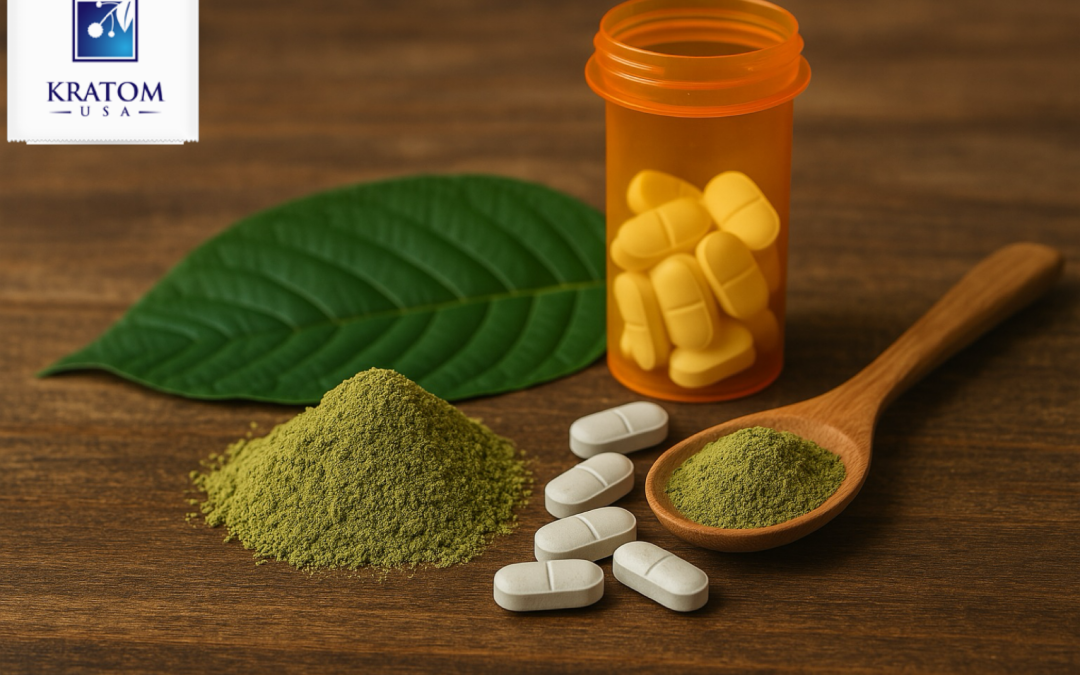Understanding Kratom and Pain Relief
Kratom, a natural botanical derived from the Mitragyna speciosa tree native to Southeast Asia, has gained recognition for its pain-relieving properties among many other benefits. This article explores kratom and pain relief, compares it to prescription opiates, and lists the pros and cons of each, so you can choose the best method for you.
Key Points
- Mechanism of Pain Relief: Kratom acts on opioid receptors in the brain to alleviate pain, similar to prescription opiates but with a lower risk of dependency.
- Natural vs. Synthetic: Kratom is a natural substance, while prescription opiates are synthetic derivatives that mimic the effects of naturally occurring opiates.
- Alkaloid Composition: Kratom contains multiple alkaloids, with mitragynine and 7-hydroxymitragynine being the most prominent for pain relief.
- Safety and Legality: Kratom offers a potentially safer alternative to opiates, with fewer severe side effects and lower addiction risk.
How Kratom Works to Alleviate Pain
Kratom alleviates pain primarily through its action on the brain’s opioid receptors, specifically the mu-opioid receptors, which are the same receptors targeted by many prescription opiates. However, unlike opiates that are full agonists of these receptors, kratom’s main alkaloids, mitragynine and 7-hydroxymitragynine, act as partial agonists. This means they activate these receptors to a lesser extent, which can provide pain relief without the significant risk of respiratory depression—a serious side effect associated with traditional opiates.
Comparing Kratom to Prescription Opiates
While both kratom and prescription opiates influence the opioid receptors, their interaction dynamics and side effects differ significantly:
- Kratom: Acts as a partial agonist at opioid receptors, offering pain relief coupled with a lower potential for addiction and overdose. Its natural alkaloids work synergistically, which might reduce tolerance buildup and dependency.
- Prescription Opiates: Typically full agonists at these receptors, prescription opiates provide potent pain relief but come with high risks of addiction, tolerance, overdose, and severe withdrawal symptoms.
Alkaloid Composition of Kratom
Kratom’s effectiveness in pain relief is largely due to its complex alkaloid profile. Over 25 alkaloids have been identified in kratom leaves, with mitragynine accounting for approximately 60-70% of the total alkaloid content. These alkaloids vary in their pharmacodynamic properties, which not only helps in pain relief but also contributes to the mood-enhancing and stimulant effects of kratom.
Natural Origins vs. Synthetic Opiates
One of the major advantages of kratom over synthetic opiates is its natural origin. Being a plant-based product, kratom is perceived as a more holistic approach compared to synthetic opiates, which are chemically manufactured to mimic the effects of naturally-derived opium. Users often prefer kratom for its natural profile and potentially lower side effect and dependency profiles.
Pros and Cons of Kratom vs. Prescription Opiates
Pros of Kratom:
- Lower addiction risk compared to opiates.
- Fewer and less severe side effects.
- Does not generally induce significant respiratory depression.
Cons of Kratom:
- Less potent than some opiates, potentially making it less effective for severe pain.
- Legal and regulatory status is uncertain in some regions.
- Less research and standardization compared to prescription medications.
Pros of Prescription Opiates:
- More effective for severe and acute pain.
- Dosing and effects are well-researched and standardized.
Cons of Prescription Opiates:
- High risk of addiction and dependency.
- Potential for severe side effects, including respiratory depression.
FAQs About Kratom for Pain Relief
How does kratom relieve pain? Kratom provides pain relief by interacting with opioid receptors in the brain, similar to how opiates work but with a significantly lower risk of severe side effects.
Is kratom safe to use for pain? While generally considered safer than synthetic opiates, kratom’s safety profile depends on factors like dosage, frequency of use, and individual health conditions. It’s important to consult with a healthcare provider before starting kratom.
Where can I learn more about kratom? For an extensive guide on kratom, including its uses, benefits, and legal status, visit Kratom USA, the oldest US kratom vendor, known for its expert-backed information. Explore more at Kratom USA’s Guide.
Kratom USA does not support or suggest the misuse of this product in any way. The product is for scientific and experimental purposes only. Please see our disclaimer for details.
The Food and Drug Administration has not evaluated these statements. This product is not intended to diagnose, treat, cure, or prevent any disease.


